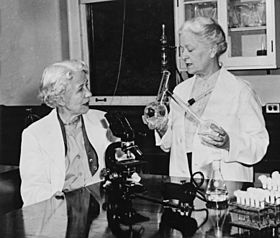Elizabeth Lee Hazen facts for kids
Quick facts for kids
Elizabeth Lee Hazen
|
|
|---|---|

Hazen (left) and Rachel Fuller Brown
|
|
| Born | August 24, 1885 |
| Died | June 24, 1975 (aged 89) |
| Nationality | American |
| Citizenship | United States |
| Alma mater | Mississippi University for Women Columbia University |
| Known for | Developing nystatin, the first anti-fungal drug |
| Awards | The Squibb Award in Chemotherapy The Rhoda Benham Award of Medical Mycological Society of the Americas The Chemical Pioneer Award of the American Institute of Chemists National Inventors Hall of Fame |
| Scientific career | |
| Fields | Microbiology |
| Institutions | New York State Department of Public Health, Division of Laboratories and Research |
Elizabeth Lee Hazen (born August 24, 1885, in Mississippi – died June 24, 1975) was a brilliant American scientist. She is most famous for helping to create nystatin. This was the very first medicine that could safely treat fungal infections in people. Her work also helped save infected trees and restore old artwork damaged by mold.
Contents
Early Life and Family
Elizabeth Lee Hazen was born on August 24, 1885. Her birthplace was a town called Rich, in Coahoma County, Mississippi. She was the middle child of William Edgar Hazen and Maggie Harper Hazen. Sadly, her parents passed away when she was only four years old. Elizabeth and her two siblings were then adopted and raised by their aunt and uncle.
Education and Learning
Elizabeth Hazen loved science and learning. She went to the Mississippi University for Women. In 1910, she earned a Bachelor of Science degree there. After college, she taught biology and physics at a high school in Jackson, Mississippi.
While teaching, she kept learning by going to summer classes. She studied at the University of Tennessee and the University of Virginia. Later, she was accepted into Columbia University for advanced studies. She earned a Master's degree in Biology in 1917. Then, in 1927, she completed her Ph.D. in microbiology. She was one of the first women to earn a doctorate from Columbia in that field. During World War I, she also worked as a lab technician for the United States Army.
Important Scientific Work
Elizabeth Hazen had a strong background in science. She continued her research on bacteria and how the body fights off diseases. In 1931, she got a job with the New York State Department of Health. She worked in a lab that diagnosed bacterial diseases in New York City.
Discovering Fungi Solutions
At this lab, she made several important discoveries. She helped find the cause of an anthrax outbreak. She also located sources of tularemia and food poisoning. Later, she moved to the Wadsworth Center in New York. There, she focused on studying fungi and fungal diseases. She started her own collection of different fungi cultures. This collection and her research helped her become famous. Her work even led to her being included in the National Inventors Hall of Fame.
Creating Nystatin
In 1948, Elizabeth Hazen teamed up with another scientist, Rachel Fuller Brown. Together, they worked to find a new medicine. They wanted to create a drug that could fight fungal infections. Their hard work led to the discovery of nystatin. This was a huge breakthrough because it was the first safe medicine for fungal infections in humans.
Getting the Patent
Hazen and Brown filed for a patent for nystatin in 1950. A patent is a special legal right. It means only the inventors can make, use, or sell their invention for a certain time. It took them six and a half years to get the patent. This was because the drug needed to be tested. It had to be proven safe and useful for people.
The FDA approved nystatin in 1954. The company Bristol-Myers Squibb then started selling it. Finally, on June 25, 1957, the U.S. Patent Office gave Hazen and Brown the patent. This protected their invention for 17 years.
Later Life and Recognition
Elizabeth Hazen continued her research in the lab for many years. Her knowledge and skills were very helpful to other scientists. She kept studying new ways to use nystatin for different health problems.
Towards the end of her life, she received many awards for her amazing work. These included the Squibb Award in Chemotherapy and the Rhoda Benham Award. She also received the Chemical Pioneer Award from the American Institute of Chemists. After she passed away, Elizabeth Hazen was honored again. In 1994, she was added to the National Inventors Hall of Fame.
See also
 In Spanish: Elizabeth Lee Hazen para niños
In Spanish: Elizabeth Lee Hazen para niños

